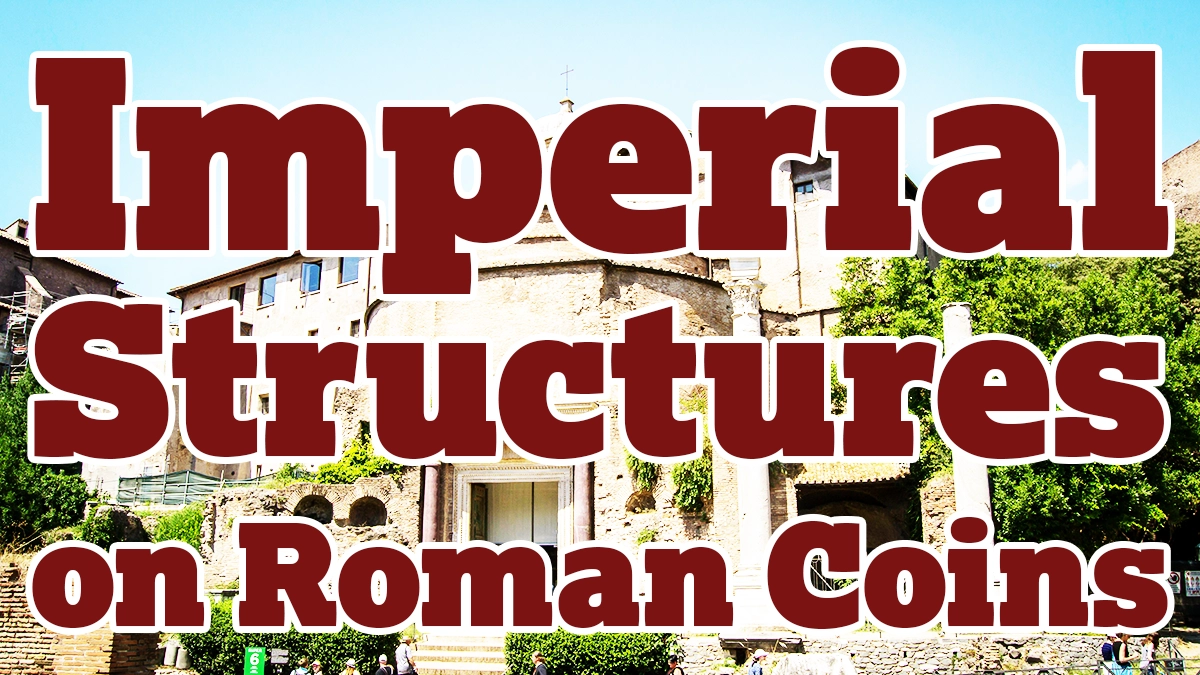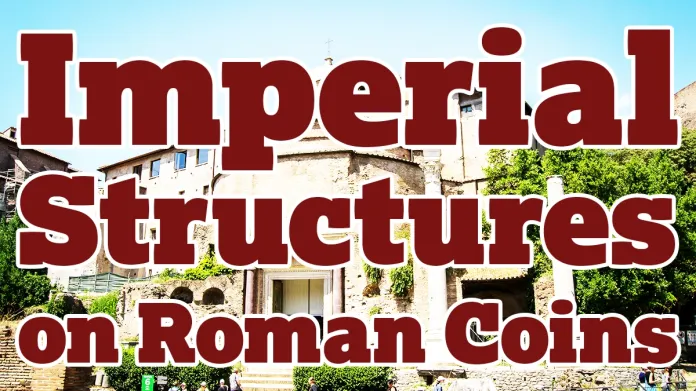
By Dr. Steve Benner for CoinWeek …..
Roman emperors (and their celators or celatores, the engravers who created the coin dies) preferred to place monumental constructions on their coinage, particularly if that they had them constructed themselves. A couple of shunned placing constructions on their cash in any respect (Tiberius, for instance), however others used architectural designs fairly regularly; do a search of “Antoninus Pius” and “temples” in one of many historical cash listed databases under and I assure you’ll have loads of hits. I actually have 10 cash with temple reverses, 4 of them that includes the Janus temple of Nero.
Sadly, the identities of most of the constructions proven on these Roman cash are unknown. Descriptions in supply paperwork typically simply say “hexastyle” (“six-columned”) or “octastyle” (“eight-columned”) temple, which doesn’t assist since most now not exist. It might be fairly useful to fashionable historians if these may very well be recognized as a result of there are numerous constructions whose look is understood solely from cash. Not one of the constructions on this article are nonetheless standing (besides the Temple of Romulus and, to some extent, the nymphaeum of Severus Alexander), so the depictions are helpful info. For instance, there have been as many as 36 arches inbuilt Rome – of which solely three nonetheless exist. Let’s check out the cash.
Determine 1 is a map of historical Rome numbered with the placement of every of the constructions lined by the cash I’ll focus on.
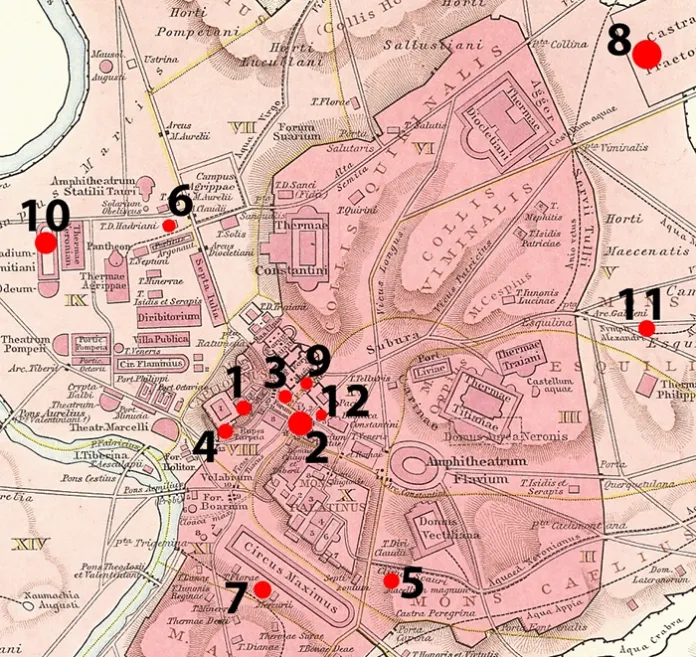
Cash of the Roman Republic (Places 1-3)
The primary denarius on this trio (Determine 2a) was initially minted by M.C. Marcellus in 50 BCE and has his profile on the obverse with a triskeles behind that reminds us of his conquest of Syracuse in 211 BCE in the course of the Second Punic Battle (the triskeles is the image of Sicily and nonetheless seems on the Sicilian flag). This explicit coin was reissued by the Emperor Trajan (98-117 BCE) in 107 or 1112/113 CE. The reverse of this denarius exhibits Marcellus carrying a Gallic trophy to the Temple of Jupiter Feretrius (“Jupiter of the Spoils”) on Capitoline Hill, which is positioned subsequent to the Temple of Jupiter Optimus Maximus (“Jupiter the Finest and Biggest”) location 1 in Determine 1). It symbolizes Marcellus’ victory in 222 BCE over the Celtic Insubres below their king Britomartus. The Temple of Jupiter Feretrius was the primary temple inbuilt Rome, the second being the one devoted to Jupiter Optimus. Romulus, the founder and first legendary king of Rome, is claimed to have devoted the temple in 752-751 BCE in appreciation for his victory over Acro, king of the Caeninenses.
The second denarius (Determine 2b) was issued by the moneyer P. Nerva in 113-112 BCE and has the helmeted head of Roma on the obverse. The reverse exhibits two residents voting within the Comitium: one receiving his poll from an attendant and one other putting his poll within the cista (“poll field”). The Comitium was the central location for political and judicial actions in Rome and was positioned within the discussion board (location 2) between the Curia (Senate Home) and the Rostra (audio system’ platform). It was a round constructing the place the Curiate Meeting met, and the place non secular festivals have been held.
The third denarius (Determine 2c) was issued by L. Mussidius Longus in 42 BCE and depicts the bust of Concordia on the obverse, The reverse has a platform inscribed CLOACIN, on which there are two statues of Venus Cloacina. This Venus was the goddess of the Cloaca Maxima, the sewage drainage system of Rome. Her small round shrine was positioned subsequent to the Basilica Aemilia within the discussion board (location 3) above the Cloaca Maxima. The 2 deities on the platform could have represented two features of Cloacina-Venus (No. 1 and a couple of). “Cloacina”–from the verb cluere, which means “to purify”–may additionally clarify why she was referred to as the “Cleanser” or “Air purifier” since she was additionally credited with the purification of marital intercourse (I may make one other joke right here, however I’d threat shedding my PG score). Later, the English used the time period “going to the Temple of Cloacina” as an idiom which means to go to the bathroom.
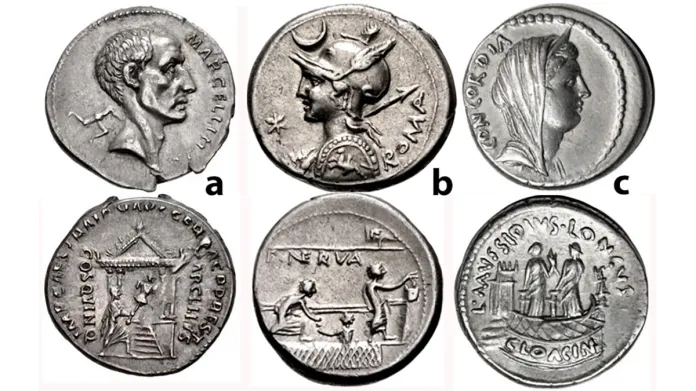
Cash of Augustus (Places 2 and 4)
Determine 3 exhibits two denarii minted by the primary Roman emperor, Augustus. Coin one exhibits Augustus on the obverse and a rostral column on the reverse (location 2 once more). Alongside the perimeters, rostra (galleys’ ramming prows) have been put in, and a statue of Augustus was positioned on high. The time period rostra (or rostrum, singular) got here from the speaker’s platform within the Discussion board, positioned in entrance of the Comitium, which was embellished with the rostra from the Battle of Antium in 338 BCE. Augustus (nonetheless Octavian on the time) in all probability constructed this column to have fun his victory at Actium in 31 BCE.
Coin two (Determine 3b) once more exhibits Augustus on the obverse however options the Temple of Jupiter Tonans (“Jupiter the Thunderer”) on the reverse. Jupiter is proven standing contained in the temple holding a scepter and a lightning bolt. This small hexastyle temple was inbuilt 22 BCE by Augustus and performed a significant position within the Secular Video games (Ludes Seculares), an inventive and non secular pageant that the emperor revived in 17 BCE. The temple (location 4) was positioned on Capitoline Hill subsequent to the Temple of Jupiter Optimus Maximus. It was famous for the paintings that was displayed round it.
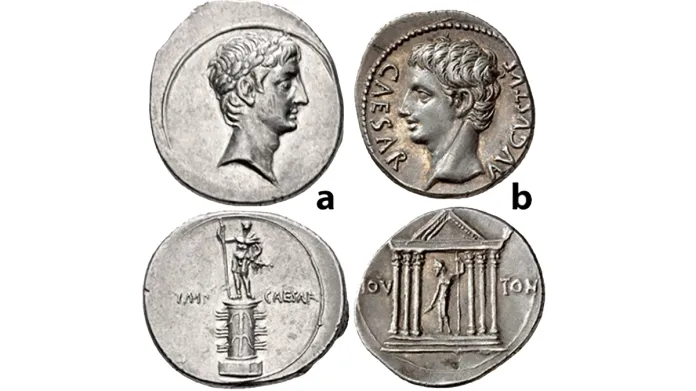
Roman Bronze and Orichalcum (Places 5-7)
Determine 4 exhibits a dupondius and two sestertii with monumental structure on their reverses. The primary coin (Determine 4a) is a dupondius of Nero (dominated 54-68 CE) together with his portrait on the obverse and the Macellum Magnum on the reverse. The Macellum was a Roman indoor market that offered primarily meat and fish however did promote different produce relying on native availability. It was positioned south of the Coliseum on the street connecting the Coliseum and the Circus Maximus (location 5). It contained a courtyard with a central tholos (a round construction with a domed roof) surrounded by tabernae and retailers all of equal dimension. Nero had the two-storied Macellum inbuilt 59 CE. The one in Pompeii is an effective extant instance of a macellum.
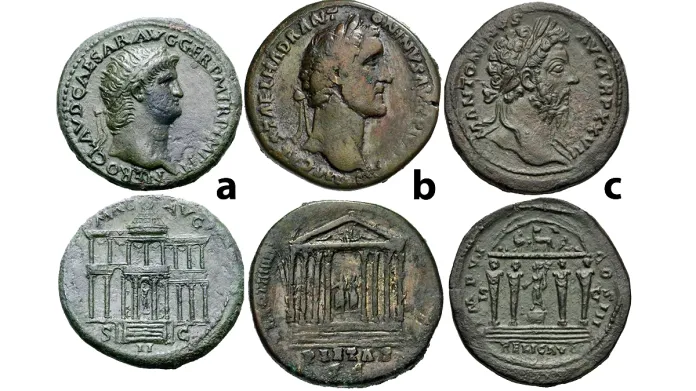
The second coin (Determine 4b) is a sestertius of Antoninus Pius (r. 138-161 CE), together with his portrait on the obverse and the Hadrianeum on the reverse. This temple was devoted to Hadrian and was constructed after his loss of life by Antoninus, his adopted son (with some opposition from the Senate which didn’t like Hadrian very a lot). The Corinthian octastyle temple had a three-step base and statues of Hadrian and his spouse Vibia Sabina inside. It was positioned within the Campus Martius (location 6) simply west of Quirinal Hill. One cella wall (an inside chamber wall of a temple) and 11 columns from the exterior colonnade nonetheless survive and have been integrated into the Carlo Fontana, now Rome’s Chamber of Commerce.
The third coin (Determine 4c) is a sestertius of Marcus Aurelius (r. 161-180 CE), together with his portrait on the obverse and the Temple of Mercury on the reverse. The temple was based in 495 BCE and was one of many oldest in Rome. It was a tetrastyle (“four-columned”) temple with Mercury standing on a pedestal inside, holding a caduceus and purse. It was positioned close to the Circus Maximus (location 7); nothing stays of it at present. Mercury was the favored Roman god of commerce, eloquence, vacationers, communication, messengers, and trickery. The reverse legend RELIG(I0) AVG could point out a particular connection to the non secular feeling of Aurelius. This coin and the prior sestertius are extraordinarily uncommon cash.
Gold Roman Cash (Places 8-11)
Determine 5 exhibits 4 aurei from 4 emperors, every highlighting completely different monuments. The primary (Determine 5a) was minted by Claudius in 41/42 CE and has him on the obverse and the Praetorian Camp on the reverse. The Camp has IMPER RECEPT (“The Emperor Acquired”) on its entrance, which is supposed to say that the emperor was introduced to the Praetorian Guard, acknowledged as Emperor, and brought below their safety. Claudius was considerably reluctantly made Emperor by the Praetorians after the homicide of Caligula (r. 37-41 CE), so he needed to suck as much as them to remain in workplace. The Camp was inbuilt 23 CE by Sejanus, Tiberius’ Praetorian Prefect. It was positioned outdoors the partitions of Rome (location 8) and later destroyed by Constantine (r. 306-337), although a few of the partitions have been integrated into the Aurelian Wall and nonetheless stand.
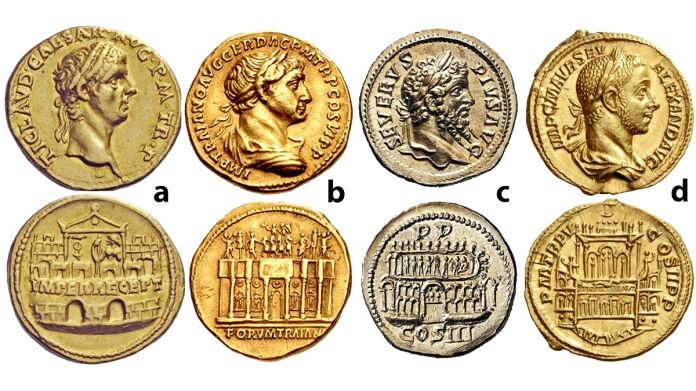
The second aureus (Determine 5b) was minted by Trajan in 112/113 CE and exhibits his Arcus Traiani, the triumphal entrance to the Discussion board Traiani (location 9). He was pleased with the huge complicated he had constructed simply north of the Discussion board, utilizing the cash he appropriated from the Dacians. It included this entrance that appeared extra like a triumphal arch than an entryway, an equestrian statue of himself, a three-story market, the Basilica Ulpia, a Temple to the deified Trajan, two libraries, and his well-known column.
Clearly, Trajan was not a worshipper of Pudicitia, goddess of modesty.
The following aureus (Determine 5c) is attention-grabbing in that the emperor on the obverse was not the one who constructed the stadium on the reverse. The coin was minted by Septimius Severus in 204 CE and has a reverse displaying the Stadium of Domitian (r. 81-96 CE), inbuilt 86 CE. Why Septimius determined to place it on his coin just isn’t identified, although maybe he hoped that its recognition would rub off on him. The Stadium is now fully gone, however its define is captured by the Piazza Navona, through which buildings incorporate the Stadium’s unique decrease arcades. This coin is extraordinarily uncommon.
The final Roman coin is an aureus minted by Severus Alexander to point out off his new Nymphaeum (Determine 5d). These have been initially pure grottoes, which, custom mentioned, have been the house of native water nymphs. Later, the Romans constructed synthetic grottoes, normally as rotundas adorned with work and statues and topped with a dome or half dome. The precise date of its building is unknown, although it was in all probability constructed earlier than 226 CE when this coin was minted. It utilized water from the Aqua Julia aqueduct and was positioned between the Through Tiburtina and Through Labicana (location 11). Substantial elements of the Nymphaeum survive at present–together with the unique basis and water channels–and are a great supply of details about Roman engineering strategies.
Cash of Romulus (Location 12)
This final construction and coin are completely different from the others mentioned right here in that it was not constructed for a god however as a memorial to an emperor’s son. This Temple/Tomb was devoted to the son of Maxentius (r. 306-312 CE), Romulus, who died in 309 CE. The follis in Determine 5 has Romulus on the obverse and the Temple on the reverse with the legend AETERNAE MEMORIAE. It was inbuilt 310 CE of masonry and located on the Through Sacra subsequent to the Temple of Antoninus and Faustina (location 12). The Tomb is spherical, with a dome and eagle on high (image of the soul of the useless Romulus), and remains to be intact as a result of it was transformed into the vestibule for the Church of S. Cosma and S. Damiano within the sixth century (Determine 6). The Temple is depicted on cash with both no columns, 4 columns, or six columns. This was as a result of there are two columns flanking the door and 4 to the correct and left. Constantine the Nice killed Maxentius on the Battle of Milvian Bridge in 312 CE and accomplished the development of this temple and the Basilica of Maxentius. The cash have been now not minted after Maxentius’ loss of life.
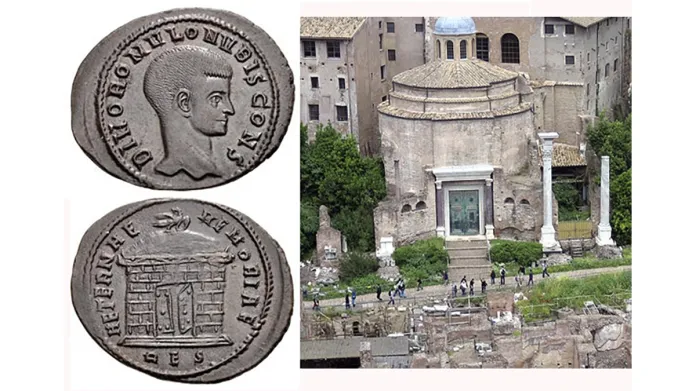
Feedback
I feel I’ve lastly accomplished my numismatic survey of Roman constructions on cash, which is unlucky since I take pleasure in writing about them. It’s academic to me since I had by no means heard of a few of these cash, just like the Nymphaeum (I’ll have to try it subsequent time I’m in Rome). Plus, once I visited the Temple of Romulus, I incorrectly thought it was devoted to the founding father of Rome. Many of the cash on this article should not frequent and, because of this, could be very costly; the follis just isn’t.
* * *
References for Imperial Constructions on Roman Cash
https://www.wildwinds.com/coins/
Boardman, John, Jasper Griffin, and Oswyn Murray. The Oxford Historical past of the Classical World. Oxford College Press: New York, London (1993).
Hornblower, Simon, Spawforth, Antony (ed.). The Oxford Classical Dictionary. Oxford (1996).
Madden, F., C.R Smith, and S.W. Stevenson. A Dictionary of Roman Cash. London (1889).
Ortega, Ivan Fumado. “Triumphal Arches”, Nationwide Geographic. (Jan/Feb 2025).
Sutherland, CHV, and RAG Carson. The Roman Imperial Coinage. Spink and Son: London (varied).
Tameanko, Marvin. Monumental Cash. Krause Publications: St. Iola, WI (1999).
* * *

